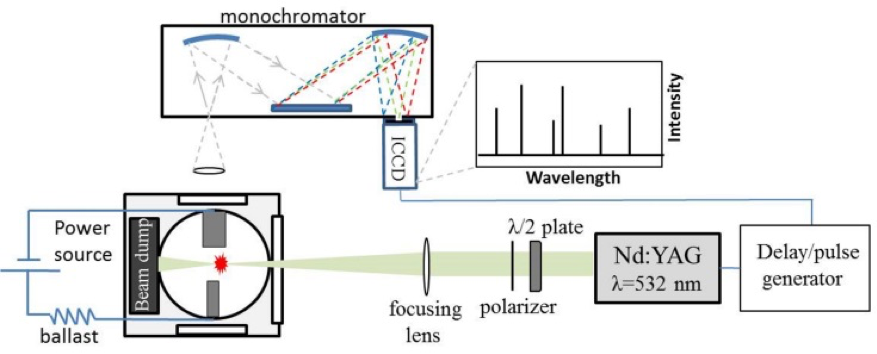Laser-Induced Breakdown Spectroscopy
Advanced Diagnostics Navigation
- Atomic and molecular species, positive and negative ions
- Laser-Induced Fluorescence (LIF) and Two-Photon Absorption LIF (TALIF)
- Radar Resonant Enhanced Multi-Photon Ionization (Radar REMPI)
- Characterization of plasma, chemical composition and dynamic behavior
- Electron velocity distribution function, gas flow velocity and temperature
- Electric field and space potential
- Nanoparticle Diagnostics
- Surface Diagnostics
Laser-Induced Breakdown Spectroscopy (LIBS)
Point measurements detecting particle synthesis regions
Capable of determining particle composition
Sensitivity threshold is particle density ≥ 108 cm-3

Laser-Induced Breakdown Spectroscopy (LIBS) deduces the elemental composition of a sample from measurement of the spectral line emission emitted by the plasma produced by high-power laser irradiation of the sample. LIBS can be applied to solids, liquids, and gases. The laser energy threshold required to induce breakdown in a gas is higher than in a solid; hence it is possible to operate at energy such that only particles in the laser focus will breakdown and produce subsequent line emission. In a situation where the region of particle coagulation and synthesis is separated from the hot region of the arc plasma we can identify the region where the particles are formed and determine their composition. The breakdown energy threshold also depends on the laser wavelength, with easier breakdown at shorter wavelengths. Breakdown induced emission is also significantly stronger at shorter laser wavelengths compared to longer wavelengths at the same intensity. A schematic diagram of the planned LIBS setup is shown in the below figure. A Nd:YAG laser with second (532 nm) or third (355 nm) harmonic output is focused in the investigation volume with a spherical lens located on a movable stage. Moving the lens allows the breakdown region to be scanned away from the axis of the arc to determine where nanoparticles appear. The radiation emitted by the breakdown plasma is imaged on the entrance slit of a monochromator and an iCCD camera records the spectrum.
 This capability is located at the Princeton Plasma Physics Laboratory.
This capability is located at the Princeton Plasma Physics Laboratory.
